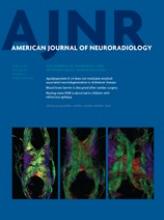Index by author
Vagberg, M.
- BrainYou have accessAutomated Determination of Brain Parenchymal Fraction in Multiple SclerosisM. Vågberg, T. Lindqvist, K. Ambarki, J.B.M. Warntjes, P. Sundström, R. Birgander and A. SvenningssonAmerican Journal of Neuroradiology March 2013, 34 (3) 498-504; DOI: https://doi.org/10.3174/ajnr.A3262
Vanbavel, E.
- LetterYou have accessReply:R. van den Berg, J.J. Schneiders, S.P. Ferns, C.B. Majoie and E. VanbavelAmerican Journal of Neuroradiology March 2013, 34 (3) E33; DOI: https://doi.org/10.3174/ajnr.A3514
Vaughn, J.
- Pediatric NeuroimagingYou have accessMRI Characterization and Longitudinal Study of Focal Cerebellar Lesions in a Young Tuberous Sclerosis CohortJ. Vaughn, M. Hagiwara, J. Katz, J. Roth, O. Devinsky, H. Weiner and S. MillaAmerican Journal of Neuroradiology March 2013, 34 (3) 655-659; DOI: https://doi.org/10.3174/ajnr.A3260
Vendrell, J.-F.
- FELLOWS' JOURNAL CLUBNeurointerventionYou have accessEvaluation of an Intravenous-Endovascular Strategy in Patients with Acute Proximal Middle Cerebral Artery OcclusionJ.-F. Vendrell, R. Mernes, N. Nagot, D. Milhaud, K. Lobotesis, V. Costalat, P. Machi, I.L. Maldonado, C. Riquelme, C. Arquizan and A. BonafeAmerican Journal of Neuroradiology March 2013, 34 (3) 603-608; DOI: https://doi.org/10.3174/ajnr.A3230
Here, the safety and efficacy of mechanical thrombectomy after intravenous therapy failure were assessed in 123 patients with acute MCA occlusions. All patients imaged were within 4.5 hours of onset, had DWI ASPECTS greater than 5, and variable NIHSS scores (8–25). The authors found that mechanical thrombectomy after failure of intravenous thrombolysis improves clinical outcomes at 3 months and could represent an alternative in the management of patients with acute MCA occlusion. Additionally, no symptomatic intracranial hemorrhages were detected in patients treated this way, suggesting this protocol is safe.
Vermersch, P.
- Spine Imaging and Spine Image-Guided InterventionsYou have accessPulse-Triggered DTI Sequence with Reduced FOV and Coronal Acquisition at 3T for the Assessment of the Cervical Spinal Cord in Patients with MyelitisJ. Hodel, P. Besson, O. Outteryck, H. Zéphir, D. Ducreux, A. Monnet, D. Chéchin, M. Zins, M. Rodallec, J.P. Pruvo, P. Vermersch and X. LeclercAmerican Journal of Neuroradiology March 2013, 34 (3) 676-682; DOI: https://doi.org/10.3174/ajnr.A3254
Vinters, H.V.
- EDITOR'S CHOICEBrainYou have accessProbabilistic Radiographic Atlas of Glioblastoma PhenotypesB.M. Ellingson, A. Lai, R.J. Harris, J.M. Selfridge, W.H. Yong, K. Das, W.B. Pope, P.L. Nghiemphu, H.V. Vinters, L.M. Liau, P.S. Mischel and T.F. CloughesyAmerican Journal of Neuroradiology March 2013, 34 (3) 533-540; DOI: https://doi.org/10.3174/ajnr.A3253
Images from over 500 patients with glioblastoma were used to build location atlases corresponding to genetic and biologic abnormalities as well as prognosis based on age. Most glioblastomas grew into the periventricular regions adjacent to the subventricular zone. MGMT promoter methylated tumors occurred more frequently in the left temporal lobe in young patients, in IDH1 mutant tumors, in those having the proneural gene expression subtype, and in tumors lacking loss of PTEN that occurred most frequently in the frontal lobe. MGMT methylated tumors with IDH1 mutation tended to occur in the left frontal lobe. EGFR amplified and EGFR variant 3-expressing tumors were found most frequently in the left temporal lobe. Tumors in the left temporal lobe were associated with favorable response to radiochemotherapy and increased survival.








